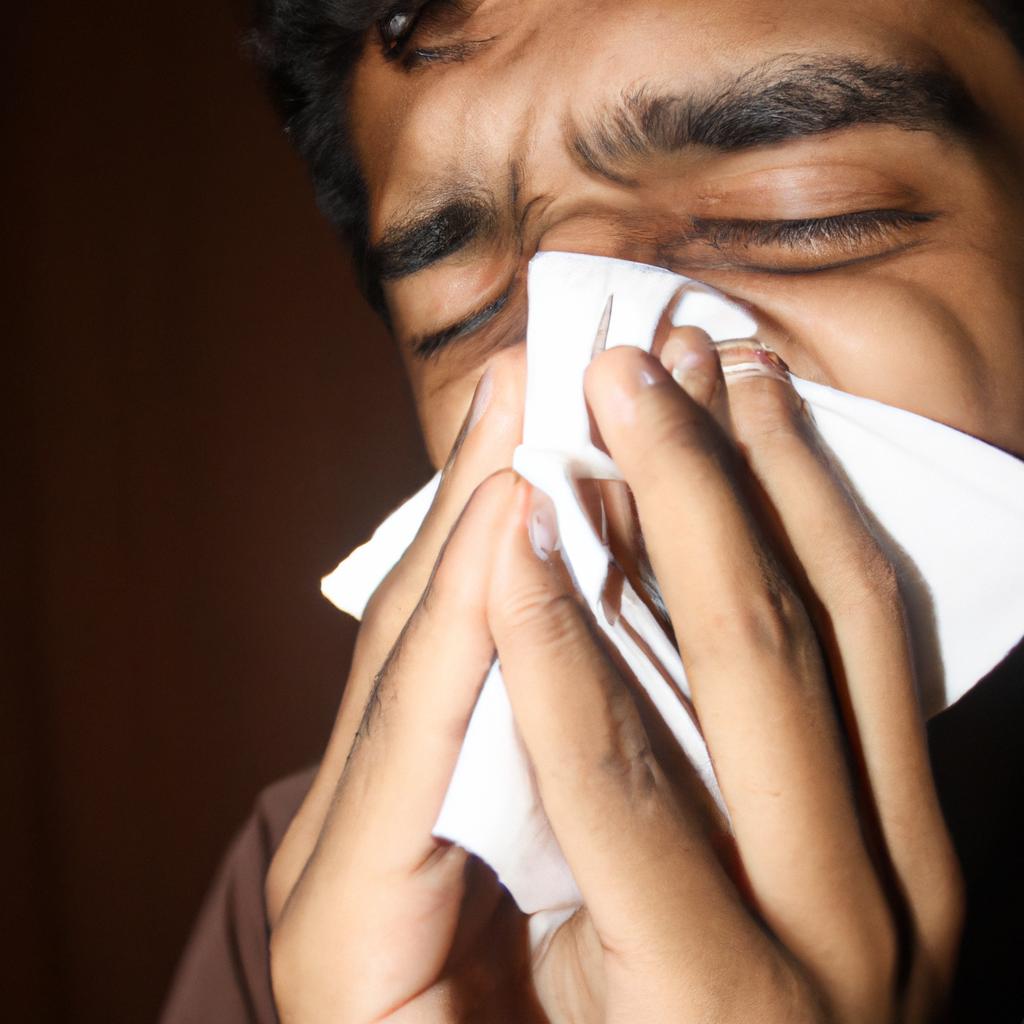Allergies are a prevalent health concern affecting individuals worldwide. From mild discomfort to severe life-threatening reactions, allergies can significantly impact an individual’s quality of life and daily activities. This comprehensive guide aims to provide an in-depth understanding of the different types of allergies that exist, their causes, symptoms, diagnostic methods, and potential treatment options.
Consider the case study of Sarah, a 35-year-old woman who recently developed a persistent cough accompanied by itchy eyes and nasal congestion after adopting a new puppy. Despite her love for animals, Sarah found herself struggling with these uncomfortable symptoms whenever she was around her furry friend. She sought medical advice and discovered that she had developed allergic rhinitis triggered by pet dander. Sarah’s experience highlights how allergies can arise from various sources and manifest through diverse symptoms impacting multiple organ systems.
Understanding the mechanisms underlying different types of allergies is crucial for accurate diagnosis and effective management strategies. This article will delve into common allergens such as pollen, dust mites, certain foods, insect venom, medications, and animal dander – exploring their interactions with the immune system and elucidating why some individuals develop hypersensitivity reactions while others remain unaffected. By gaining insight into the intricacies of allergy development, healthcare professionals and individuals alike can better understand how to prevent, manage, and treat allergies.
Allergies occur when the immune system overreacts to normally harmless substances (allergens) in the environment. In individuals with allergies, exposure to these allergens triggers a series of immune responses that result in the release of antibodies, particularly immunoglobulin E (IgE). IgE binds to specialized cells called mast cells and basophils, which are abundant in tissues such as the nose, eyes, lungs, and skin.
Upon subsequent exposure to the same allergen, the bound IgE on mast cells and basophils recognize and bind to the allergen. This interaction prompts the release of various chemicals, including histamine and leukotrienes, into the surrounding tissues. These substances cause inflammation and produce symptoms characteristic of allergic reactions.
The symptoms of allergies can vary depending on the type of allergy and the organs involved. Common symptoms include sneezing, itchy or watery eyes, runny or congested nose (rhinitis), coughing or wheezing (asthma), hives or skin rashes (urticaria), gastrointestinal disturbances like vomiting or diarrhea (food allergies), and even anaphylaxis – a severe whole-body allergic reaction that can be life-threatening.
To diagnose allergies accurately, healthcare professionals may employ various methods. These include a thorough medical history assessment to identify potential triggers or patterns of symptoms. Additionally, skin prick tests can be performed by placing small amounts of suspected allergens onto the skin’s surface and observing for localized allergic reactions. Blood tests measuring specific IgE levels against particular allergens can also aid in diagnosis.
Once diagnosed with an allergy, individuals have several management options available. The primary approach involves avoiding exposure to known allergens through environmental modifications such as using air purifiers for pet dander allergies or avoiding certain foods for food allergies. Medications like antihistamines help alleviate immediate symptoms by blocking the effects of histamine, while nasal corticosteroids can reduce inflammation and congestion in allergic rhinitis.
For severe allergies or cases where avoidance and medications are insufficient, allergen immunotherapy (commonly known as allergy shots) may be recommended. This treatment involves gradually introducing increasing amounts of specific allergens into the body to desensitize the immune system over time. Immunotherapy can provide long-term relief and potentially modify the natural course of allergies.
In conclusion, understanding the different types of allergies, their causes, symptoms, diagnostic methods, and treatment options is crucial for both healthcare professionals and individuals affected by allergies. By recognizing the underlying mechanisms involved in allergic reactions, effective prevention strategies can be implemented, appropriate treatments administered, and overall quality of life improved for those living with allergies.
Common Allergies
Allergies are a common occurrence, affecting individuals worldwide. They can manifest in various forms and have diverse triggers. Understanding the different types of allergies is crucial for effective management and prevention. This section will provide an overview of some common allergies, their symptoms, triggers, and available treatment options.
Let’s consider an example to illustrate how allergies can impact daily life. Imagine Sarah, a 30-year-old woman who loves spending time outdoors. Every spring, as soon as the flowers bloom and trees release pollen into the air, she starts experiencing itchy eyes, sneezing fits, and nasal congestion. These symptoms persist throughout the season and significantly affect her quality of life. Sarah is diagnosed with seasonal allergic rhinitis or hay fever—a type of allergy triggered by airborne allergens such as pollen.
- Allergic Rhinitis: Also known as hay fever, it causes symptoms like sneezing, itching nose or throat, watery eyes, and nasal congestion.
- Asthma: A chronic respiratory condition characterized by wheezing, shortness of breath, chest tightness, and coughing.
- Eczema: An inflammatory skin disorder causing redness, itchiness, dryness, and sometimes blistering.
- Contact Dermatitis: A localized reaction occurring when the skin comes into contact with substances like certain metals (e.g., nickel), cosmetics, or latex gloves.
Now imagine a table that provides additional information about these common allergies:
| Allergy | Symptoms | Triggers | Treatment Options |
|---|---|---|---|
| Allergic Rhinitis | SneezingItching nose or throatWatery eyes | PollenDust mitesPet dander | AntihistaminesNasal sprays |
| Asthma | WheezingShortness of breathChest tightness | Allergens (pollen, dust mites)Infections | Inhalers (bronchodilators, corticosteroids) |
| Eczema | RednessItchinessDry skinBlistering | Irritants (soaps, detergents)Allergens (pollen, food) | MoisturizersSteroid creams |
| Contact Dermatitis | RashBlisters | Metals (nickel)Cosmetics and fragrances | Avoidance of triggersTopical corticosteroids |
Understanding the symptoms, triggers, and available treatments for these common allergies can help individuals make informed decisions about their health. It is essential to consult with healthcare professionals for accurate diagnosis and personalized advice.
Transitioning into the subsequent section on “Food Allergies,” let’s delve further into allergies that are specifically triggered by certain types of food. By exploring this aspect, we can gain a more comprehensive understanding of the diverse range of allergies affecting people worldwide.
Food Allergies
Types of Allergies: A Comprehensive Guide
Moving on from common allergies, let us now delve into the realm of food allergies. Imagine a scenario where Sarah, a 10-year-old girl, experiences an immediate reaction after consuming peanuts during lunch at school. Her face swells up, she breaks out in hives, and struggles to breathe. This real-life case study highlights the seriousness of food allergies and the need for awareness.
Food allergies occur when the immune system mistakenly identifies certain proteins in food as harmful substances. The body then releases chemicals like histamine to combat these perceived threats, resulting in various allergic reactions ranging from mild symptoms such as itching or swelling to severe anaphylaxis that can be life-threatening.
To better understand the landscape of food allergens and their prevalence, here are four key points:
- More than 170 foods have been identified as potential triggers for allergic reactions.
- The top eight most common allergenic foods include milk, eggs, peanuts, tree nuts (such as almonds and walnuts), soybeans, wheat, fish, and shellfish.
- Food allergies affect approximately 6% to 8% of children and 2% to 4% of adults globally.
- Reactions can occur even with minimal exposure to the allergen, sometimes through cross-contamination or airborne particles.
To further illustrate the severity and complexity of food allergies, consider this table showcasing different types of food allergens along with their associated symptoms:
| Food Allergen | Symptoms |
|---|---|
| Peanuts | Swelling, difficulty breathing |
| Milk | Hives, vomiting |
| Shellfish | Abdominal pain |
| Wheat | Itchy skin rash |
As we conclude our discussion on food allergies, it is important to note that individuals with diagnosed food allergies must diligently manage their condition by avoiding trigger foods and carrying necessary medication, such as epinephrine auto-injectors. By understanding the risks associated with food allergies and taking appropriate precautions, we can ensure a safer environment for those affected.
The subsequent section will explore seasonal allergies, specifically focusing on common triggers and effective management strategies to alleviate symptoms.
Seasonal Allergies
Types of Allergies: A Comprehensive Guide
In the previous section, we explored the various types of food allergies and their symptoms. Now, let us delve into another common category known as seasonal allergies. To illustrate this further, consider the case of Sarah, a 32-year-old woman who experiences severe allergic reactions every spring when pollen levels are high.
Seasonal allergies, also referred to as hay fever or allergic rhinitis, occur when individuals have an immune response to airborne substances such as tree pollen, grass pollen, or mold spores during specific times of the year. These allergens can trigger symptoms like sneezing, itchy eyes, runny nose, and congestion in susceptible individuals. For instance, Sarah’s allergy symptoms intensify during the spring months due to her sensitivity to tree pollens.
To better understand seasonal allergies, here are some key points:
- Seasonal allergies commonly occur during certain periods throughout the year.
- Environmental factors such as weather conditions and geographical location can influence the severity of these allergies.
- Pollen counts tend to be higher on warm and windy days compared to cooler and rainy ones.
- Managing seasonal allergies often involves avoiding triggers through measures like staying indoors with closed windows during peak pollen times.
Now let’s take a look at a table summarizing different types of allergens that can cause seasonal allergies:
| Allergen Type | Common Sources | Symptoms |
|---|---|---|
| Tree Pollens | Oak trees, Birch trees | Sneezing, itchiness |
| Grass Pollens | Bermuda grass, Timothy grass | Runny nose |
| Weed Pollens | Ragweed, Sagebrush | Congestion |
| Mold Spores | Damp areas | Itchy eyes |
This table provides insight into the diverse range of allergens that may contribute to seasonal allergies and the associated symptoms. By understanding these allergens, individuals can take appropriate precautions to minimize their exposure and alleviate discomfort.
As we conclude this section on seasonal allergies, it is important to note that while they may cause significant inconvenience and discomfort, proper management strategies can greatly improve quality of life for affected individuals.
[Transition into subsequent section about “Drug Allergies”]: Moving forward from our discussion on seasonal allergies, let us now delve into the world of drug allergies and unravel its intricacies.Drug Allergies
Section H2: Drug Allergies
Imagine a scenario where Sarah, a 32-year-old woman with chronic migraines, visits her doctor to discuss treatment options. After assessing her symptoms and medical history, the doctor prescribes a commonly used medication for migraine relief. Excited about finding potential relief, Sarah diligently takes her first dose of the medication. However, within minutes, she experiences severe itching all over her body accompanied by hives and difficulty breathing. Alarmed by this unexpected reaction, Sarah realizes that she may be allergic to the prescribed drug.
Drug allergies occur when the immune system mistakenly identifies certain medications as harmful substances and launches an attack against them. While most people tolerate medications without any adverse reactions, some individuals develop hypersensitivity responses that can range from mild skin rashes to life-threatening systemic reactions like anaphylaxis. Understanding drug allergies is crucial in order to identify potential triggers and prevent future complications.
To help you grasp the complexities of drug allergies, here are four key points:
- Common allergenic drugs: A variety of medications have been associated with allergic reactions. Some common culprits include antibiotics (such as penicillin), nonsteroidal anti-inflammatory drugs (NSAIDs) like aspirin or ibuprofen, anticonvulsants used for seizure disorders, and chemotherapy agents.
- Symptoms: The signs and symptoms of drug allergies can vary widely depending on the individual and severity of the reaction. Mild cases may present with skin manifestations such as hives or rash, while more severe reactions can involve respiratory distress (e.g., wheezing or shortness of breath), gastrointestinal issues (e.g., vomiting or diarrhea), or cardiovascular collapse.
- Diagnostic challenges: Diagnosing drug allergies can be complex due to several factors, including delayed onset of symptoms after initial exposure and overlapping clinical presentations with other conditions such as viral infections. Various diagnostic tests exist, ranging from skin prick tests to drug provocation challenges, but their interpretations require expertise and caution.
Consider the following table that illustrates different allergies based on symptoms:
| Allergy Type | Symptoms |
|---|---|
| Food Allergy | Nausea, vomiting, abdominal pain, or hives |
| Seasonal | Sneezing, runny nose, itchy eyes |
| Drug | Skin rash, itching, difficulty breathing |
As we delve deeper into the world of allergies, let us now explore the next section: Insect Sting Allergies. Understanding these specific types of allergies will provide further insight into how our bodies can react to various stimuli.
Section H2: Insect Sting Allergies
Insect Sting Allergies
Allergic reactions to insect stings can range from mild discomfort to life-threatening emergencies. For instance, let us consider the case of Sarah, a 35-year-old woman who experienced an allergic reaction after being stung by a bee during a picnic. Within minutes of the sting, she developed hives and started experiencing difficulty breathing. Luckily, her friend recognized the severity of the situation and immediately administered epinephrine, which helped alleviate her symptoms until medical help arrived.
Insect sting allergies are triggered when an individual’s immune system overreacts to venom injected into their body through stings or bites from insects such as bees, wasps, hornets, fire ants, and certain types of flies. The venom contains proteins that act as allergens for some people, leading to an immune response. Symptoms may include localized pain, swelling at the site of the sting or bite, redness, itching, hives (urticaria), and in severe cases, anaphylaxis – a potentially life-threatening reaction characterized by difficulty breathing, dizziness or fainting, rapid heartbeat, and swelling of the face and throat.
To better understand insect sting allergies and their impact on individuals’ lives:
- It is estimated that up to 3% of adults worldwide experience systemic allergic reactions following insect stings.
- Insect sting allergies can develop at any age; however, they tend to be more common in adults than children.
- Those who have previously experienced an allergic reaction to an insect sting are at higher risk for future severe reactions.
- Avoidance measures such as wearing protective clothing and using insect repellents can significantly reduce the risk of getting stung.
Table: Common Insects Associated with Sting Allergies
| Insect | Venom Characteristics | Reaction Severity |
|---|---|---|
| Bees | Acidic | Moderate |
| Wasps | Alkaline | Severe |
| Hornets | Alkaline | Severe |
| Fire Ants | Alkaloid | Moderate to Severe |
In conclusion, insect sting allergies can have a profound impact on individuals’ lives, ranging from mild discomfort to potentially life-threatening situations. Recognizing the signs and symptoms of an allergic reaction is crucial for prompt treatment with antihistamines or epinephrine in severe cases. In our next section, we will explore another common type of allergy: skin allergies. Understanding these different types of allergies equips us with valuable knowledge in managing and preventing potential reactions.
Skin Allergies
Types of Allergies: A Comprehensive Guide
Insect Sting Allergies
Moving on from the discussion on insect sting allergies, we now delve into another common type of allergy that affects many individuals—skin allergies. Let’s explore this topic in detail and gain a better understanding of its causes, symptoms, and available treatments.
Skin allergies can manifest in various ways, but one typical example is contact dermatitis caused by exposure to certain substances. For instance, imagine a person who develops redness, itching, and a rash after coming into direct contact with poison ivy. This hypothetical case study serves as an illustrative example of how skin allergies can arise due to external factors.
- Skin allergies are often triggered by allergens such as certain metals (e.g., nickel), cosmetics or personal care products containing fragrances or preservatives.
- Symptoms may include itchiness, redness, swelling or hives at the site of contact.
- Common types of skin allergies include eczema (atopic dermatitis), allergic contact dermatitis, and urticaria (hives).
- Treatment options for skin allergies range from topical corticosteroids and antihistamines to avoidance strategies and lifestyle modifications.
Now let’s take a closer look at some important aspects related to skin allergies through the lens of a three-column table:
| Causes | Symptoms | Treatments |
|---|---|---|
| Irritant | Itching | Topical Corticosteroids |
| Allergic | Redness | Antihistamines |
| Environmental | Swelling | Avoidance strategies |
| Hives | Lifestyle modifications |
This table provides a concise overview encompassing major causes, associated symptoms, and potential treatment approaches for managing skin allergies effectively.
In summary, it is crucial to recognize and understand the various types of allergies, such as skin allergies. By identifying potential triggers and symptoms, individuals can take appropriate measures to alleviate discomfort and seek suitable treatments. Whether it be through avoiding irritants or utilizing prescribed medications, managing skin allergies can greatly improve one’s quality of life.
 Web Firma
Web Firma



